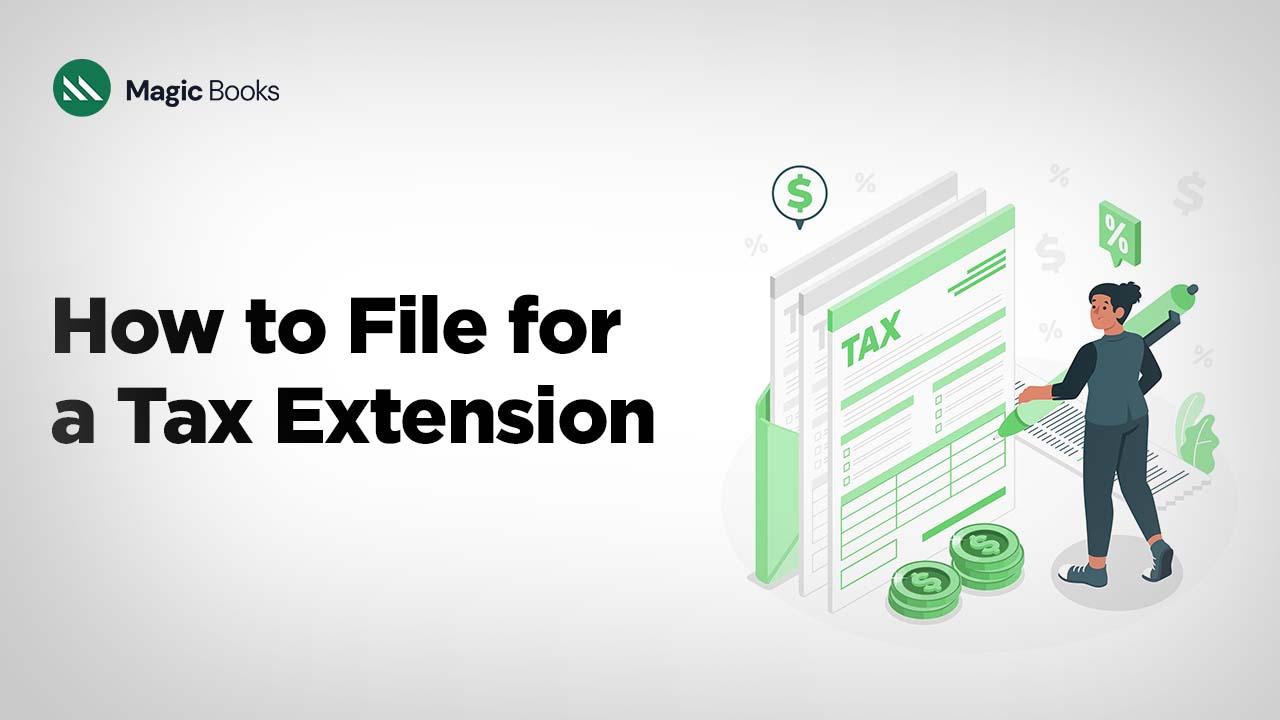The United States small business sector experiences many managing-finances difficulties across 2025 specifically while doing taxes. Business owners should master tax extension filing knowledge to handle client circumstances while staying penalty-free and maintaining correct financial records. Due to its extended deadline, a tax extension helps companies prepare documents correctly and eliminate their need to pay late fees, therefore representing an important tool that simplifies business taxation.
The knowledge of tax extension procedures along with payment requirements stands as an important skill for business owners.
Tax extension permits companies to file their accurate returns later instead of postponing any tax liabilities they need to pay. Any extension of tax time does not reduce the obligation for business owners to pay their expected taxes by the original deadline except to prevent penalties and interest charges. The tax extension process demands strategic management along with prompt actions to handle tax obligations in ways that allow proper financial documentation management. To obtain an extension business owners need to comprehend the Internal Revenue Service (IRS) requirements for making such applications. Organizations operating as small businesses may file their extension application with Form 7004 to inform the IRS about their need to postpone their income tax submission. Making sure the form contains precise information is crucial because late submission of the form before the original deadline creates non-compliance with federal laws.
The Step by Step Process:
Early strategic planning enables the filing process to progress without interruptions.
Small business owners can use the tax extension filing process because it was made for people with numerous commitments. Financial advisors recommend starting early with tax preparations since postponements may cause trouble during tax return finishing. The use of a properly planned extension request creates immediate tax relief by extending deadlines to examine financial statements get professional guidance and make essential changes to accounting practices. The planned approach leads to precise filing processes and avoids mistakes that come up when filings are hurriedly completed.
Talking with tax consultancies leads to filing accuracy
Owners should rely on trustworthy sources and professional help while handling tax extensions due to the intricate nature of tax legislation. Guidance provided by the IRS and federal agencies through their information comes with critical instructions which help users file correctly. Financial experts emphasize how precise recordkeeping alongside exact liability prediction helps taxpayers stay updated on tax policy changes that change the filing process. The extension filing procedures become more efficient when these practices are applied which leads to improved business financial health.
Proactive Steps for Filing a Tax Extension
You should treat tax extension filing as an early preventive step before waiting until the very last minute. Unpredicted business events such as financial document delays coupled with operation changes demand an extra timeframe to finalize tax filings. The extension application period creates an occasion for owners to examine their financial information in detail alongside the income record analysis and account reconciliation they need before their formal declaration. The high level of dedication ensures that avoidable mistakes that could trigger audit penalties and other complications remain prevented.
Gathering Essential Financial Documentation
A business owner needs to start an extension filing process by compiling financial records that apply. The compilation of income statements and expense reports bank statements along with other records that represent business activities becomes necessary for business owners. Financial accuracy in these documents remains vital because the IRS makes decisions directly from this provided information. The extension process and annual tax return reporting benefit from both the logical arrangement and current state of financial records according to professional opinions of accountants and financial consultants. The precision of estimated tax payments depends on comprehensive documentation because this type of filing documentation strengthens tax payment accuracy and minimizes potential issues throughout IRS examinations.
Submission Methods
The 7004 Form can reach the IRS by electronic means in addition to regular mail services yet businesses prefer electronic submission because it saves time and enhances efficiency.
But before we explore any future, let us tell you what Form 7004 is.
What Is Form 7004?
Form 7004, officially titled the “Application for Automatic Extension of Time To File Certain Business Income Tax, Information, and Other Returns,” is used by eligible businesses—such as corporations, partnerships, and certain trusts—to request additional time to file their federal tax returns. It’s important to note that while the form extends the time to file, it does not extend the time to pay any taxes owed.
Where Can You Get Form 7004?
You can download Form 7004 directly from the IRS website (irs.gov). The form is available in PDF format along with detailed instructions on how to complete and file it. Additionally, many tax professionals and tax preparation software programs offer access to Form 7004 as part of their services, often with added guidance to ensure correct completion.
When submitting Form 7004 electronically business owners need to verify correct input of all data while obtaining IRS confirmation of receipt. Steps for filing Form 7004 demand the completion of sections that clarify business information and tax liability expectations and the primary reason for seeking an extension. The delivery of the document requires certified mail services to guarantee its safe arrival at the proper IRS office.
The Extension plays a specific role in affecting tax liability while allowing more time for submission.
A tax extension acts only as a delay system for tax filings but does not establish the actual amount of taxes owed. Taxpayers working with an extension need to file complete tax returns which must show their true business earnings but also all their allowable deductions and tax credits. The extension system gives additional time for a business to check and confirm the accuracy of the submitted details. Small businesses need to collaborate with tax experts for professional advice about best practices and to confirm that their subsequent tax return submits accurate information that follows all present tax requirements.
Leveraging Electronic Filing Tools
The IRS and various tax preparation software platforms present electronic services that help streamline the entire filing process. Tool interfaces guide business owners using step-by-step processes to fill in financial data and validate their data entries. Automatic system checks detect potential submission errors which improves the chance of avoiding processing lags. The technological progress helps small business owners as it gives them an inexpensive way to handle tax filing tasks even without full-time accounting staff.
Addressing Common Filing Challenges
The process of submitting tax extension forms contains many hurdles that will result in form errors or delays when not effectively controlled. The most common difficulty occurs when individuals try to provide accurate information on Form 7004. The IRS initiates a long series of additional review questions when just one small mistake occurs such as an improper business identification number or incorrect financial input; thus small business owners must check each box twice to ensure accuracy. The process of verification stands as crucial for data migration from accounting systems to filing platforms because errors during data entry become evident only after filing.
Most filling systems present challenges because small business owners need to learn their technological requirements. Electronic systems aimed at efficiency might cause some technical problems and compatibility issues which disturb the submission flow. Technological problems with IRS servers together with inconsistent internet connectivity may affect the delay in verifying final confirmation of receipt. Business owners should resolve these issues by filing their taxes in advance while performing test submissions and implementing dependable up-to-date software. The majority of tax preparation applications now feature built-in error-checking algorithms to identify inconsistencies as users enter data which minimizes technical errors.
Business owners should be cautious about miscommunications with the IRS because they pose one of the most critical risks in the filing process. After submission, the IRS sends notices that mandate swift resolution of detected errors and omissions. Response times to IRS correspondence about such issues can worsen the situation because punitive penalties and additional interest costs might be imposed. To resolve any issues that emerge the small business should have either an internal representative or external tax professional managing clear communication with the IRS. Small business owners should establish thorough documentation systems for IRS communications because this proves essential when resolving discrepancies between the business and tax authority.
Tax regulations that change constantly create more difficult challenges in the tax filing process. The periodic updates and modifications to tax laws as well as filing guidelines require business owners to keep themselves informed. New estimated tax payment provisions together with changed extension filing criteria affect the way a business should prepare its extension request. Small business managers can stay prepared for tax transformations by following trusted tax information through subscribing to news from sources like the IRS as well as regularly consulting tax professionals. Use of these strategies keeps filing operations in sync with current regulations which reduces the possibility that errors occur because of obsolete data.
The correct estimation of tax liabilities presents a widespread problem because of uncertain economic factors. Like many small businesses, small companies find it difficult to predict their year-end financial standing when their revenues show considerable movement throughout the year. Placing incorrect estimates in tax returns results in double the issues they cause both incorrect filing and unanticipated tax obligations when preparing the final tax return. Businesses benefit from periodic financial evaluation through professional tax adviser guidance to produce better projection estimates. A combination of expense and income reconciliation and a substantial review of quarterly financial reports enables better tax obligation forecasting which produces fewer filing problems while extending deadlines.
Most small business operators encounter difficulties when trying to combine different data sets in their operations. Tax reports require proper organization of financial data that exists in separate software applications including payroll and invoicing systems which leads to consolidation difficulties. Organizations should deploy accounting systems able to automatically unite data between separated sources to simplify this process. Such solutions prevent human mistakes and create central financial dashboards that help businesses assess their financial state and deliver error-free Form 7004 submissions.
Effective management of standard filing challenges requires computing possible errors beforehand and creating preventive measures to prevent each one. Small business owners who validate each detail while using trusted digital resources stay in contact with the IRS and adapt to changing tax regulations minimize their chances of filing mistakes when they complete extensions. Using established record-keeping practices alongside updated data and integrated accounting systems creates an approach that lets business leaders handle tax filing complexities smoothly and accurately. Proactive action with tax compliance creates double benefits through both smooth filing process management and sustainable financial stability.
Small business owners can effectively handle their tax obligations using tax extension files as a beneficial management instrument. The complete process requires business owners to carefully prepare and document everything while seeking professional help to succeed. A thorough strategy prevents penalties and strengthens the financial state of the enterprise. Business owners who implement the outlined guidelines will accomplish tax compliance while building sustainable growth for their organizations. A strong financial standing requires business owners to keep both proactive planning and ongoing financial monitoring alongside compliance in an ever-changing tax environment.


